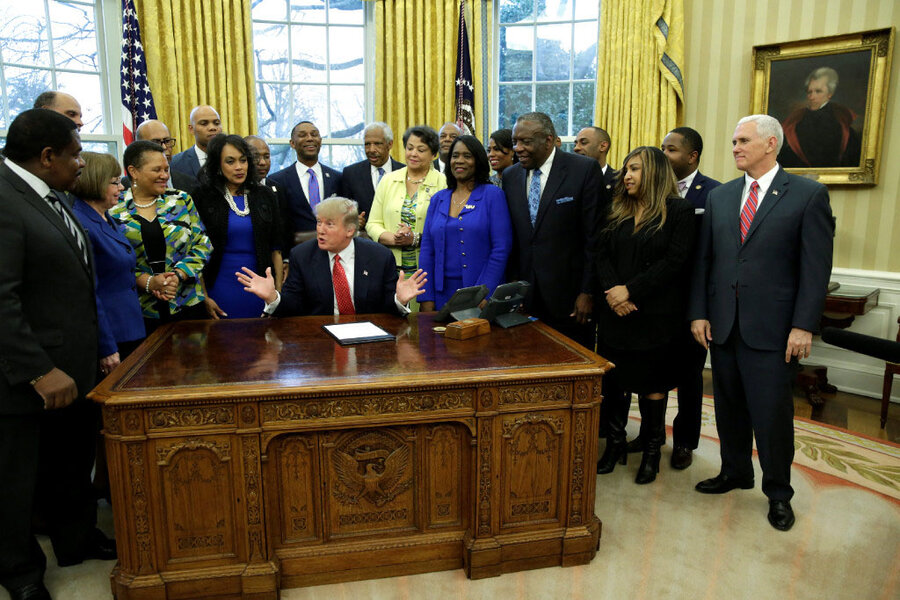After Trump issues executive order backing HBCUs, work remains for their supporters
Loading...
After meeting with leaders from dozens of America’s Historically Black Colleges and Universities (HBCUs), President Trump signed an executive order on Tuesday aimed at strengthening these institutions.
The order directed federal agencies that regularly work with HBCUs to create annual plans to help the schools reap more benefits from those relationships; created a President's Board of Advisors on HBCUs; and moved the decades-old White House Initiative on HBCUs from the Department of Education to the Executive Office at the White House.
“By being there, we will greatly enhance the chances that HBCUs will be prioritized in the federal budget and critical jobs initiatives,” Johnny C. Taylor, Jr., the president and chief executive of the Thurgood Marshall College Fund, tells The Christian Science Monitor in an email.
As leader of the College Fund, Mr. Taylor advocates and raises funds for America’s more than 100 HBCUs, many of which have struggled with financial woes in recent years. He takes the executive order as a sign of the administration’s “position that HBCUs matter.”
Decades after the desegregation of public universities, black college leaders and outside experts say that these schools help African-Americans compete on a playing field that’s still tilted against them. While Tuesday’s news is encouraging, they also see a need for improvements that go beyond a shake-up in the federal bureaucracy.
“These are institutions that have a larger mission than simply classroom education,” Richard America, a former Professor of the Practice at Georgetown University’s McDonough Business School and an expert on race and education, tells the Monitor in an email. “They will remain important as effective problem solvers, buffers, and rallying points” for the black community, so long as any racial stratification exists in the United States.
Many HBCUs began as a response to segregation, opening after the Civil War to provide a college education for African-Americans who typically found themselves barred from other colleges. Today, some non-black students attend the schools, but educating African-Americans remains their primary mission.
While black students continue to graduate at lower rates than their white counterparts nationwide, research has found that they often fare better at HBCUs than at predominantly-white institutions.
“HBCU students report more frequent and favorable relationships with their professors, earn higher college grades, report greater gains in critical and analytical thinking, and are more likely to earn a graduate or professional degree than their black peers at predominantly white institutions,” according to the New American Foundation. “Scholars cite the mission and history of HBCUs as the reason for these greater impacts on graduates.”
Nonetheless, HBCUs' overall graduation rates are even lower than average, at 30 percent, although 22 percent of the institutions have higher-than-average graduation. But, as HBCU advocates often point out, more of these schools’ students tend to come from challenging circumstances, like poverty and poorer K-12 school districts, than students at other institutions, making graduation more challenging. When those factors are taken into consideration, the New America Foundation says, "recent research indicates that HBCU graduation rates compare favorably with other (non-black) institutions."
But even if HBCUs currently serve students from those backgrounds better than other schools do, Georgetown’s Mr. America says that they can do better still, if there’s a concerted effort to improve them.
“It's up to their boards of trustees, which need to improve,” he says in a phone interview. “It's up to their leadership, which needs to improve, it's up to their alumni, which need to dig much much deeper in terms of support. And it's up to the schools themselves to change their strategy, their vision, their mission.”
But he doesn’t let public servants off the hook either. “For 100 years,” he explains, “the people who've allocated those resources at every level skewed their decisions or biased their decisions in favor of white institutions. So money that should've gone to [historically-black] Alabama State University went to the University of Alabama instead.”
In 1991, a US District Court identified “disparate levels of state funding for higher education between historically white universities (HWUs) and historically black colleges and universities (HBCUs)” as one of several “actionable vestiges of discrimination” in Alabama’s higher-education system. More recently, Maryland, South Carolina, and other states have also been accused of shortchanging their public HBCUs, the Monitor’s Cristina Maza reported in 2015.
After meeting with Mr. Trump and Vice President Mike Pence this week, Taylor, of the Thurgood Marshall Fund, says that they both “understood HBCUs had been historically underfunded and that they would be doing something about it. While they did not commit to any particular number, the commitment was clear and unequivocal.”
Now, he and his colleagues want to maintain that commitment, and pin down some “particular numbers” for HBCU funding. A statement issued by the United Negro College Fund also expressed support for Trump’s executive order, but made clear that “None of UNCF’s funding recommendations [for HBCUs] were included.”
The Fund, it continued, had hoped to see “an aspirational goal” that HBCUs receive “five percent of total federal grant, internship and cooperative agreement funding and 10 percent of total federal contract funding awarded to colleges and universities,” as well as “concrete commitments for annual funding growth at each federal agency reflected in agency budgets.”
Taylor, too, wants the White House to follow up its executive order with dollars and cents.
“Our message was simple to the Administration yesterday and to the Republican Leadership: While we are very happy to be brought to the table in your first 45 days, we need to see concrete actions that show your support of HBCUs, namely a significant allocation in the federal budget,” he says.






